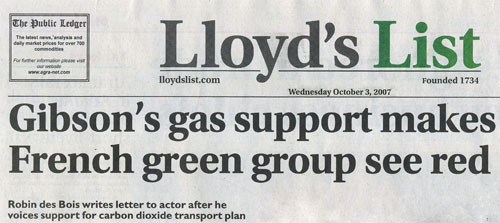Open letter to Mel Gibson
Dear Mel Gibson,
In the Lloyd’s List of September 12th 2007 in the article “From carbon footprints to CO2 ship blueprints” we read that you openly show your support to a project to design vessels twice the size of a normal capesize bulker to transport carbon dioxide (CO2). “BW Shipping boss Andreas Sohmen-Pao reveals green ambitions and has ally in actor Mel Gibson”. This would be done with the intention to use the CO2 “to make oil and gas fields more productive” i.e. Enhanced Oil Recovery (EOR). More than 40 Mt of CO2 are currently used each year in the United States to recover oil. Most of the CO2 comes from deep natural accumulations of CO2 while about 5 % comes from industrial sources. Some of the CO2 used in EOR today is stocked in the well from where it escapes in the mid term, with the exception of the Weyburn oil field pilot project in Canada where the CO2 is recaptured and re-injected for permanent sequestration.
Robin des Bois a French NGO has been fighting for the protection of Man and the Environment since 1985. Robin des Bois has for over 20 years been involved, in the banning of waste storing and waste dumping in or under the world’s oceans. We have very strong reservations on the concepts and projects exposed at the Forbes Global CEO Conference in Singapore by Mr Sohmen-Pao. More generally we have serious doubts on currently exposed Carbon Capture and Storage (CCS) technological solutions.
Sinking trees
The Goro Nickel project in New Caledonia is catastrophic for the marine environment and coral reefs. The project is also disastrous for the terrestrial environment. The forest fires in New Caledonia demonstrate the insufficient means and techniques at human disposition to fight against the catastrophies. This insufficiency on land also holds true for the ocean and coastlines. The black chemical tides generated by the arrival of raw materials and Goro Nickel mine exportations would not be counteractable. The Polmar plan (Marine Pollution Plan) and means in New Caledonia are laughable.
Whales in the mud
The New Caledonia project conducted by the Canadian mining company Inco, known in Canada and Central America for infractions against human rights and the environment, must immediately be stopped by the French government, specifically the Minister of Finances, who contributes to the project, as well as the Minister of Ecology, who is responsible for the protection of biodiversity in New Caledonia.
“Goro Nickel”, a project conceived entirely by Inco, expects to produce 50,000 tons of nickel and 5,400 tons of cobalt a year by 2007/2008 via an experimental technique that uses sulfuric acid under high pressure, the storage of dangerous goods and mining residues, dozens of radioactive sources, and the contamination would mire the coral reefs and the depending fish in the lagoons of southern New Caledonia. The proposal for this preserved ecosystem to gain World Heritage status was withdrawn by France in October, 2002. The Minister of Ecology stated, “The status is useless because it isn’t binding, and it will be more effective to protect the environment by working with the mining companies.”
The subterranean canal and the combined nickel and cobalt refining is expected to reject a flux of 45,000m3/day containing among others several tons of suspended materials, manganese, copper, aluminium, zinc, iron, arsenic, cadmium, organic substances, sulfates, and chromium into the ocean.
In their critical analysis of the request for authorization, INERIS* attempted to bridge the gaps in the studies of the impact concerning the quasi-totality of the project and the long-term prediction of the effects of bioaccumulation of the pollutants on the marine species. The sanitary effects of marine food-chain contamination—there are hundreds of small-scale fishermen working in the zone—are no longer addressed.
The lagoons threatened by the toxic influence of Inco are vital areas for multiple marine mammals of two orders: sirenias with the sporadic observation of dugongs, and cetaceans—blue whale, minke whale, sperm whale—perhaps the most important of which, the humpback whales of the South Pacific who migrate between the Tonga Islands, New Zealand, Australia, and New Caledonia. These populations are strictly protected by international convention, which has prohibited humpback whaling since 1966.










